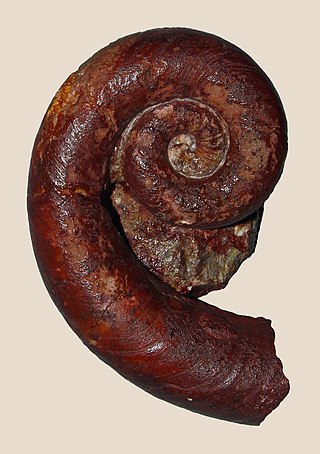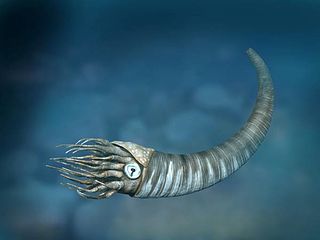
Nautiloids are a group of marine cephalopods (Mollusca) which originated in the Late Cambrian and are represented today by the living Nautilus and Allonautilus. Fossil nautiloids are diverse and speciose, with over 2,500 recorded species. They flourished during the early Paleozoic era, when they constituted the main predatory animals. Early in their evolution, nautiloids developed an extraordinary diversity of shell shapes, including coiled morphologies and giant straight-shelled forms (orthocones). Only a handful of rare coiled species, the nautiluses, survive to the present day.

Aphetoceras is a genus of tarphycerid cephalopod within the Estonioceratidae; loosely coiled without an impression along the dorsal margin; early whorls barely reaching, separating then diverging in the final mature whorl; weakly ribbed in some. The cross section of Aphetoceras is higher than wide, making it compressed in form. The dorsum, along the inner curve, is more broadly rounded than the venter which lies along the outer curve. The siphuncle is relatively large, located near but not at the ventral margin; lined with secondary deposits. Chambers are empty.

Trocholites is a tarphycerid genus in the family Trocholitidae from the Middle and Late Ordovician with a gradually expanding, weakly ribbed shell; whorls in contact, dorsum slightly impressed; cross section depressed, venter and sides rounded; siphuncle close to but not at the dorsal margin.

Discoceras is an extinct marine cephalopod mollusk, a member of the Trocholitidae in the Tarphycerida. It is distinct from Discosorus, It is characterized by closely coiled, gradually expanding shells with a subquadrate cross section, that may be ribbed or smooth. The sides are broadly rounded; the venter is wide and slightly rounded. The maximum width is slightly dorsal of the middle. The dorsum has a slight to moderate impression. The siphuncle starts off central for the first half whorl then becomes marginodorsal in the succeeding two whorls, then subdorsal at maturity. As with Trocholites, the dorsal siphuncle in Discoceras probably indicates an orientation during life that places the back of the living chamber high in the shell.

The Tarphycerida were the first of the coiled cephalopods, found in marine sediments from the Lower Ordovician to the Middle Devonian. Some, such as Aphetoceras and Estonioceras, are loosely coiled and gyroconic; others, such as Campbelloceras, Tarphyceras, and Trocholites, are tightly coiled, but evolute with all whorls showing. The body chamber of tarphycerids is typically long and tubular, as much as half the length of the containing whorl in most, greater than in the Silurian Ophidioceratidae. The Tarphycerida evolved from the elongated, compressed, exogastric Bassleroceratidae, probably Bassleroceras, around the end of the Gasconadian through forms like Aphetoceras. Close coiling developed rather quickly, and both gyroconic and evolute forms are found in the early middle Canadian.
Beekmanoceras is a small cephalopod from the Middle Canadian Epoch of New York with a loosely coiled, gyroconic, shell in which the whorls are not in contact and the siphuncle is on the inner or concave side of the whorl. Furnish and Glenister (1964) placed Beekmanoceras in the Trocholitidae (Tarphycerida), interpreting the curvature to be ventral side convex, i.e. exogastastric and the siphuncle to be dorsal. Flower (1964) included Beekmanoceras in the Ellesmeroceratidae believing the siphuncle to be ventral and the curvature to be endogastric with the ventral side concave.
Litoceras is a trocholitid (Tarphycerida) genus that has been found in the Lower and Middle Ordovician of Newfoundland. Whorls in Litoceras have a broadly rounded cross section with its width greater than its height. Litoceras somewhat resembles the tarphyceratid Pionoceras from the same time, except for the siphuncle being dorsal and in the center.
Curtoceras is a genus in the tarphycerid family Trocholitidae found widespread in the late Early and Middle Ordovician of North America and northern Europe. Curtoceras has a shell that is gradually expanded, with half the fully mature body chamber divergent from the preceding volution. Whorl sections are near equidimentional with the inner margin (dosum) moderately impressed. The surface may be smooth or weakly ribbed. The siphuncle is ventral in the initial chamber and becomes dorsal after one volution. With the exception of the dorsal siphuncle, Curtoceras is somewhat similar to the tarphyceratid Campbelloceras
The Tarphyceratidae are tightly coiled, evolute Tarphycerida with ventral siphuncles. The dorsum is characteristically impressed where the whorl presses against the venter of the previous. The Tarphyceratidae are derived from Bassleroceras or possibly from some member of the Estonioceratidae.
Basslerocerida is an order of nautiloid cephalopods from the Ordovician comprising exogastric longiconic cyrtocones, that is no longer in common use.
The Bassleroceratidae is a family of gradually expanding, smooth ellesmerocerids with a slight to moderate exogastric curvature, subcircular to strongly compressed cross section, and ventral orthochaonitc siphuncle. The ventral side is typically more sharply rounded than the dorsal side and septa are close spaced. Connecting rings are thick and slightly expanded into the siphuncle, making the segments slightly concave; characteristic of the Ellesmerocerida.

The Lituitidae are a family of evolved tarphycerids characterized by a long orthoconic section that follows a coiled juvenile portion at the apex, along with a generally tubular siphuncle, which like that of the barrandeocerids is composed of thin connecting rings.
Rhynchorthoceras is a Middle Ordovician genus characterized by a rapidly expanded, weakly annulate orthocone, like the orthoconic section of Ancistroceras, but with only a curved, cyrtoconic apex instead of juvenile whorls.
Bassleroceras is an elongate upwardly curved, exogastric, genus with the venter on the under side more sharply rounded than the dorsum on the upper. The siphuncle is ventral, composed of thick-walled tubular segments in which connection rings thicken in towardly as in both the Ellesmerocerida and primitive Tarphycerida.

The Estonioceratidae are a family of loosely coiled tarphycerids in which the inner side of the whorls, which forms the dorsum, is rounded or flat with no impression, and in which the siphuncle, composed of thick tubular segments, is located ventrally. The Estonioceratidae seem to form a link between the ancestral Bassleroceratidae and the more tightly coiled Tarphyceratidae.
The Nautilitoidea is a superorder within the subclass Nautiloidea, comprising the phylogenetically related Nautilida, Oncocerida, and Tarphycerida.
Hardmanoceras is a tarphycerid genus belonging to the Trocholitidae from the upper Lower Ordovician to possibly the lower Middle Ordovician, found in Western Australia. Hardmanoceras is like Discoceras but prominently ribbed and with a depressed whorl section. The body, or living, chamber is long, 1 1/8 volutions long. The ultimate portion is slightly divergent, not an uncommon characteristic of tarphycerids.
The Barrandeocerina comprise a suborder of Early Paleozoic nautiloid cephalopods, primitively coiled but later forms may be cyrtoconic, gyroconic, torticonic, and even breviconic, all having empty siphuncles with thin connecting rings. The Barrandeocerina were originally defined as a separate order by Rousseau Flower, but since then have been united within the Tarphycerida as a suborder. Derivation is from the Tarphyceratidae.
Aethoceras is a genus of Tarphycerida nautiloids included in the family Estonioceratidae for which the shell is a loosely coiled, gradually expanding dextral torticone with a slightly depressed whorl section. Siphuncle small, ventral, submarginal. Whorl section somewhat resembles early stages of Estonioceras in being laterally fanged. Trochoidal coiling brings to mind the later Trocholitidae. Aethoceras was originally found in the lower Ordovician of Western Australia.

Multiceratoidea is a major subclass or superorder of Paleozoic nautiloid cephalopods. Members of this group can be characterized by nautilosiphonate connecting rings, with an organic inner layer and outer layer of calcitic spherules and blades, similar to the modern nautilus. The earliest-diverging multiceratoids have oncomyarian muscle scars, though several orders trend towards a ventromyarian condition. Multiceratoid shells are generally short and curled, with a relatively small aperture (opening). Cameral deposits are never found among the multiceratoids, though several orders are known to bear endosiphuncular deposits within their siphuncles.








